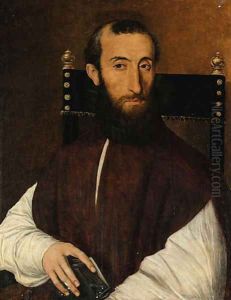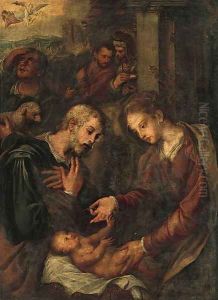Scipione Pulzone Da Gaeta Paintings
Scipione Pulzone, also known as Il Gaetano, was an Italian Renaissance painter born in Gaeta, then part of the Kingdom of Naples, in 1544. Pulzone's precise training and early influences remain somewhat obscure, but his work exhibits the refined technique and attention to detail characteristic of Roman and Neapolitan painting traditions of the time. He is particularly noted for his portraiture, which displayed a remarkable ability to capture not only the physical likeness but also the subtle nuances of character and social stature of his subjects. Pulzone's portraits were highly sought after by the Roman aristocracy and the Catholic Church, establishing him as one of the most prominent painters in late 16th-century Rome.
Pulzone's religious works also garnered significant attention. His altarpieces and devotional paintings are characterized by their serene and devout compositions, meticulous execution, and the delicate use of color, which together create a profound spiritual impact. Among his most celebrated religious works is the 'Madonna and Child', which showcases his skill in rendering the human figure with divine grace and tenderness.
Despite his success, Pulzone was somewhat overshadowed by the rising stars of the Baroque movement, which began to flourish towards the end of his career. However, his contribution to the Italian Renaissance, particularly in the realm of portraiture, remains significant. Pulzone's ability to blend naturalism with an idealized elegance prefigures some of the stylistic developments of the Baroque period.
Scipione Pulzone died in Rome in 1598. His legacy lives on through his influential works, which continue to be studied and admired for their technical precision, emotional depth, and aesthetic beauty. Pulzone's paintings are held in many prestigious collections and museums around the world, testament to his enduring appeal and the high regard in which he is still held by art historians and connoisseurs alike.

